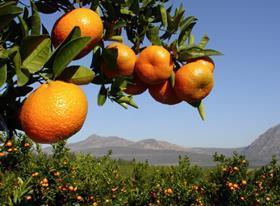
Overall citrus export volumes from the Southern Hemisphere are expected to be 6 per cent higher than last year. This will be 11 per cent higher than the average export volume from the Southern Hemisphere for the past five years.
According to figures released by the Southern Hemisphere Association of Fresh Fruit Exporters (SHAFFE) and circulated by South African Citrus Growers Association show that oranges make up the bulk of citrus exports at 1.5m tonnes. This will increase by 7.5 per cent over the previous year, however, the SHAFFE secretariat cautions that this figure may be reduced due to the navel fruit drop in South Africa.
Lemon exports are up 2 per cent up on 2016 at nearly 620,000 tonnes, while mandarins at are 4 per cent higher at 546,000 tonnes. Grapefruit is almost completely supplied by South Africa and shows an almost 14 per cent increase over the drought affected 2016 volumes. This year’s export figure of 240,000 tonnes will be similar to 2015 levels.
South Africa, with an export volume of 1,842m tonnes, accounts for 63 per cent of Southern Hemisphere citrus exports and, according to SHAFFE, has a big influence on the estimated volumes. The influence of South Africa is greatest in the grapefruit sector, where South African fruit accounts for 98 per cent of exports, but is also significant in oranges, with 76 per cent market share.
The fruit drop phenomenon in navels will impact on the export prediction from South Africa. The original estimate showed a 12 per cent increase in oranges, but this will now be reduced to an 8.5 per cent increase. South Africa accounts for 42 per cent of Southern Hemisphere lemons. The South African prediction of 263,000 tonnes represent an increase of 16 per cent over 2016.
SHAFFE says mandarins are the most competitive citrus sector. South Africa’s almost 200,000 tonnes represent 36 per cent of the Southern Hemisphere offer – increasing by 8.5 per cent over 2016 export volumes.
In South America, exports from Peru are predicted to rise 7 per cent to 136,500 tonnes. The bulk of Peruvian exports is represented by mandarins at 120,000 tonnes, which is 7 per cent higher than 2016. Uruguay expects an annual growth of 4 per cent in exports to 111,100 tonnes. Orange exports from Uruguay will increase by almost 8 per cent to 60,000 tonnes; while lemon (15,000 tonnes), mandarin (36,000 tonnes) and grapefruit (100 tonnes) exports mirror the 2016 volumes.
Argentina, on the other hand, is predicting a drop in exports across the board, with the total export crop estimated at 338,000 tonnes. Lemons (260,000 tonnes) represent the biggest Argentinian category, a fall of 7 per cent compared to 2016. Oranges (45,000 tonnes) drop by 31 per cent, while mandarins (33,000 tonnes) drop by 33 per cent. Overall, Argentina's citrus exports are predicted to drop by 14 per cent.
Chilean exports will increase by 3.5 per cent to 257,600 tonnes. This is due to a 13 per cent increase in mandarin exports to 109 000 tonnes. Lemon exports are expected to decrease by 5 per cent to 72,000 tonnes, while orange exports remain unchanged at 75,000.
Australia has indicated that its crop is late and hence the forecast remains provisional at a volume similar to 2016 – 219,500 tonnes of citrus exports.






No comments yet